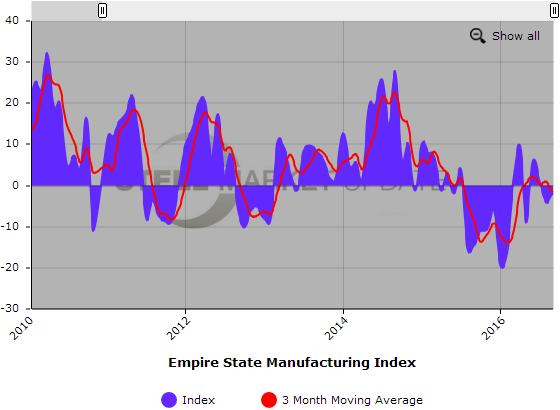Economy

Empire State Index in Contraction for 2nd Month
Written by Sandy Williams
September 15, 2016
The Empire State Manufacturing Index remained below the zero “no growth” level at -2.0 in September for the second consecutive month. Analysts point to weak export orders and sluggish business investment by the manufacturing sector.
New orders dropped eight points to -7.5 and shipments plunged 18 points to -9.4. Indexes for unfilled orders and delivery times remained in contraction. Inventories declined at a faster pace this month, dropping eight points to -12.5. The price indexes were relatively unchanged from August, indicating slight increases for input and selling prices.
Employment levels were also down in September. The employment index fell 13 points to -14.3 and the average work week index lost 14 points, registering -11.6.
Despite current weak conditions, manufacturers were more optimistic about future conditions than they were last month. The future business index jumped 11 points to 34.5 with new orders advancing as well. The future shipment index declined slightly but was still positive. Manufacturers said they expect to hire more workers to hire more workers in the coming months. Input prices and selling prices are expected to increase significantly over the next six months. Indexes for future capital expenditure and technology spending both climbed to 10.7.
Below is a graph showing the history of the Empire State Manufacturing Index. You will need to view the graph on our website to use its interactive features, you can do so by clicking here. If you need assistance logging into or navigating the website, please contact our office at 800-432-3475 or info@SteelMarketUpdate.com.

Sandy Williams
Read more from Sandy WilliamsLatest in Economy

New York state manufacturing index drops again in April
Firms were pessimistic, with the future general business conditions index falling to its second lowest reading in the more than 20-year history of the survey

Construction adds 13,000 jobs in March
The construction sector added 13,000 jobs, seasonally adjusted, in March, but tariffs could undermine the industry.

Supply chains, end-users brace for impact from tariffs
Supply chains are working through what the tariffs mean for them

ISM: Manufacturing expansion loses steam after two months of growth
US manufacturing activity slowed in March after two straight months of expansion, according to supply executives contributing to the Institute for Supply Management (ISM)’s latest report.

Chicago Business Barometer rose to 16-month high in March
The Chicago Business Barometer increased for the third-consecutive month in March. Despite this, it still reflects contracting business conditions, as it has since December 2023.

